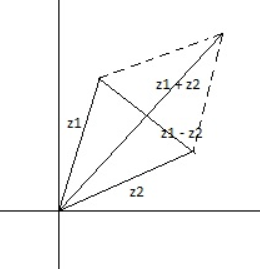
Let z1 and z2 be two complex numbers such that z1 $\ne $ z2 and |z1| = |z2|. If z1 has positive real part and z2 has negative imaginary part, then $\dfrac{{{z}_{1}}+{{z}_{2}}}{{{z}_{1}}-{{z}_{2}}}$ may be which of the following:
(a) Purely imaginary
(b) Real and positive
(c) Real and negative
(d) None of these
Answer
600.3k+ views
Hint: Consider vectors along the position vector of z1 and z2 in the Argand Plane and with magnitude equal to |z1| and |z2|. A rhombus will be formed as shown in the figure with z1 + z2 and z1 - z2 in the directions of the diagonals. Use the fact that the diagonals of a rhombus are perpendicular to each other to get z1 + z2 and z1 - z2 will be perpendicular to each other. This means that $\dfrac{{{z}_{1}}+{{z}_{2}}}{{{z}_{1}}-{{z}_{2}}}$ will have an argument of $\pm \dfrac{\pi }{2}$ which gives us the final answer.
Complete step by step answer:
In this question, we are given that z1 and z2 are two complex numbers such that z1 $\ne $ z2 and |z1| = |z2|. Also, z1 has a positive real part and z2 has a negative imaginary part.
Using this information, we need to find the nature of $\dfrac{{{z}_{1}}+{{z}_{2}}}{{{z}_{1}}-{{z}_{2}}}$.
We are given that |z1| = |z2|.
Consider vectors along the position vector of z1 and z2 in the Argand Plane and with magnitude equal to |z1| and |z2|.
A rhombus will be formed. Consider the rhombus formed as shown in the figure below:

The vector along z1 + z2 will be in the direction of one of the diagonals, while the vector along z1 - z2 will be along the direction of the other diagonal.
We know that the diagonals of a rhombus are perpendicular to each other.
Hence, z1 + z2 and z1 - z2 will be perpendicular to each other
So, $\dfrac{{{z}_{1}}+{{z}_{2}}}{{{z}_{1}}-{{z}_{2}}}$ will have an argument of $\pm \dfrac{\pi }{2}$.
Hence, $\dfrac{{{z}_{1}}+{{z}_{2}}}{{{z}_{1}}-{{z}_{2}}}$ will be purely imaginary.
So, option (a) is correct.
Note: We can solve this question by another lengthy method also. Let z1 = a + bi and z2 = c + di. Now, find $\dfrac{{{z}_{1}}+{{z}_{2}}}{{{z}_{1}}-{{z}_{2}}}$by substituting these. Simplify this and then use the fact that |z1| = |z2| to get ${{a}^{2}}+{{b}^{2}}={{c}^{2}}+{{d}^{2}}$. Substitute this in the previous expression to get the answer.Students should remember if z1 + z2 and z1 - z2 are perpendicular to each then $\dfrac{{{z}_{1}}+{{z}_{2}}}{{{z}_{1}}-{{z}_{2}}}$ will have an argument $\pm \dfrac{\pi }{2}$.
which says the real part is 0 i.e It is purely imaginary.
Complete step by step answer:
In this question, we are given that z1 and z2 are two complex numbers such that z1 $\ne $ z2 and |z1| = |z2|. Also, z1 has a positive real part and z2 has a negative imaginary part.
Using this information, we need to find the nature of $\dfrac{{{z}_{1}}+{{z}_{2}}}{{{z}_{1}}-{{z}_{2}}}$.
We are given that |z1| = |z2|.
Consider vectors along the position vector of z1 and z2 in the Argand Plane and with magnitude equal to |z1| and |z2|.
A rhombus will be formed. Consider the rhombus formed as shown in the figure below:

The vector along z1 + z2 will be in the direction of one of the diagonals, while the vector along z1 - z2 will be along the direction of the other diagonal.
We know that the diagonals of a rhombus are perpendicular to each other.
Hence, z1 + z2 and z1 - z2 will be perpendicular to each other
So, $\dfrac{{{z}_{1}}+{{z}_{2}}}{{{z}_{1}}-{{z}_{2}}}$ will have an argument of $\pm \dfrac{\pi }{2}$.
Hence, $\dfrac{{{z}_{1}}+{{z}_{2}}}{{{z}_{1}}-{{z}_{2}}}$ will be purely imaginary.
So, option (a) is correct.
Note: We can solve this question by another lengthy method also. Let z1 = a + bi and z2 = c + di. Now, find $\dfrac{{{z}_{1}}+{{z}_{2}}}{{{z}_{1}}-{{z}_{2}}}$by substituting these. Simplify this and then use the fact that |z1| = |z2| to get ${{a}^{2}}+{{b}^{2}}={{c}^{2}}+{{d}^{2}}$. Substitute this in the previous expression to get the answer.Students should remember if z1 + z2 and z1 - z2 are perpendicular to each then $\dfrac{{{z}_{1}}+{{z}_{2}}}{{{z}_{1}}-{{z}_{2}}}$ will have an argument $\pm \dfrac{\pi }{2}$.
which says the real part is 0 i.e It is purely imaginary.
Recently Updated Pages
Master Class 8 Maths: Engaging Questions & Answers for Success

Class 8 Question and Answer - Your Ultimate Solutions Guide

Master Class 7 Maths: Engaging Questions & Answers for Success

Class 7 Question and Answer - Your Ultimate Solutions Guide

Master Class 6 Maths: Engaging Questions & Answers for Success

Class 6 Question and Answer - Your Ultimate Solutions Guide

Trending doubts
What is meant by exothermic and endothermic reactions class 11 chemistry CBSE

Which animal has three hearts class 11 biology CBSE

10 examples of friction in our daily life

One Metric ton is equal to kg A 10000 B 1000 C 100 class 11 physics CBSE

1 Quintal is equal to a 110 kg b 10 kg c 100kg d 1000 class 11 physics CBSE

Difference Between Prokaryotic Cells and Eukaryotic Cells




